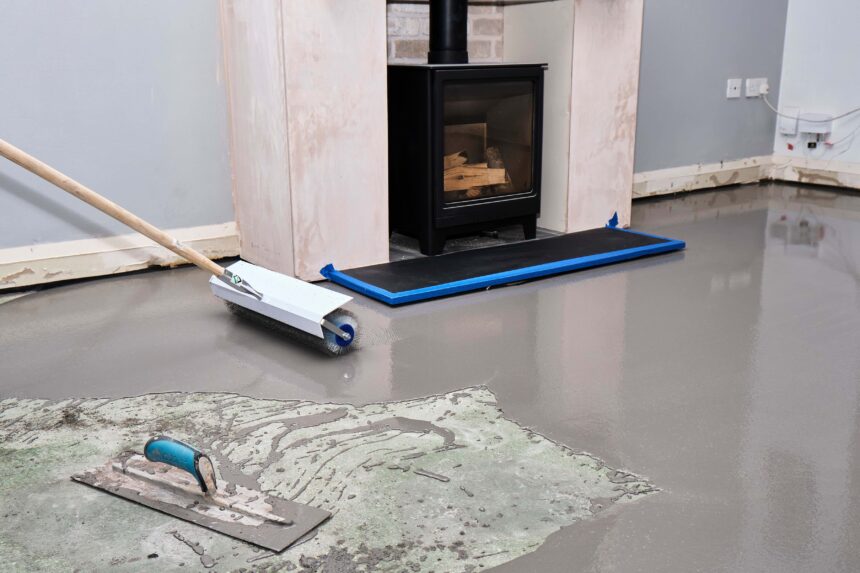The Knowledge: Smooth Installations

In this series, we tell you what you need to know to ensure flooring installations live up to high customer expectations.
Last issue, we dealt with identifying and dealing with excess subfloor moisture, the leading cause of floor failure. This time, we go a step further in the subfloor preparation process and discuss smoothing compounds, including selecting the most appropriate type.
Foundation level
F. Ball recommends the application of a smoothing compound as part of any flooring installation to optimise the appearance and longevity of the finished floor. These cement-based products are supplied as water-mix or bag and bottle versions (where the bag is mixed with a specialist liquid). After mixing, they are applied to the subfloor to create a smooth base to prevent imperfections affecting the finished result.
While formulations with specialist features are often advantageous, or even highly recommended, general-purpose options are ideal for many situations.
Fast-track applications
Examples of when it will be advantageous to use a specialist smoothing compound include working to tight timescales.
The fastest-drying smoothing compound on the market, F. Ball’s Stopgap Fast-Track 30, is walk-on hard from just 30 minutes after application and ready to receive floorcoverings in as little as 45 minutes. Another development that has sped up subfloor preparation is the arrival of smoothing underlayments that can be applied directly over old adhesive residues, such as F. Ball’s Stopgap 1200, eliminating the need to spend valuable time mechanically removing them, which is required when applying commercial smoothing compounds.
When it comes to preparing floors that will be subject to heavy loads or high levels of foot traffic, a heavy-duty smoothing compound, such as F. Ball’s Stopgap 300, will ensure that installations can withstand this kind of treatment for years to come. The application of a heavy-duty smoothing compound is also recommended prior to the installation of wood floorcoverings, as they are better able to withstand the extra strain exerted by the natural movement of the material.
Other situations
The application of a smoothing compound that is designed to accommodate slight movements or flexing in the subfloor is recommended when working over flexible subfloors, such as plywood. These products include F. Ball’s Stopgap 700, which is reinforced with tiny fibres that maintain the integrity of the smoothing compound when subject to minor subfloor movement as a result of normal foot traffic or temperature fluctuations.
When working over electrical wired or water-fed underfloor heating systems that are increasingly installed over subfloors as part of new build or refurbishment projects, it is advisable to allow at least 15mm of a special-purpose smoothing compound above the pipes to avoid hotspots and ensure its structural integrity. F. Ball’s Stopgap 1600 was created especially for this purpose.
Efficient solutions
General-purpose smoothing compounds are often the best choice when working over subfloors in a good condition, perhaps in multiple areas, such as new-build developments, and there is no requirement for advanced features, such as suitability for use over adhesive residues or flexible substrates. Apart from being a cost-effective option, the ease with which some formulations can be applied helps flooring contractors to work quickly and efficiently.
For example, F. Ball has drawn upon the latest cement formulation technology to create a ‘best-in-class’, high flow smoothing compound: Stopgap 1400.
The two-component smoothing compound has superior self-smoothing properties, is walk-on hard from just 90 minutes after application and ready to receive floorcoverings from 12 hours. Its can be applied between 2 – 10mm thick to a wide range of absorbent and non-absorbent primed subfloors, and its low-odour, protein-free formulation allows it to be used in biologically sensitive areas.
Initial preparations
Before a smoothing compound is applied, always make sure that the subfloor is suitably sound, smooth and dry. This should include the removal of any surface contaminants. There are also situations where additional preparations, such as the use of a repair compound where sand/cement screeds are mechanically damaged, for example. The application of a primer is also recommended in almost all circumstances prior to installing a smoothing compound.
F. Ball’s technical service department is on hand Monday to Friday, 8.30am – 5.00pm to answers your questions about subfloor preparation and floorcovering installation and can also arrange site visits to identify and advise on the best course of action for any flooring project.